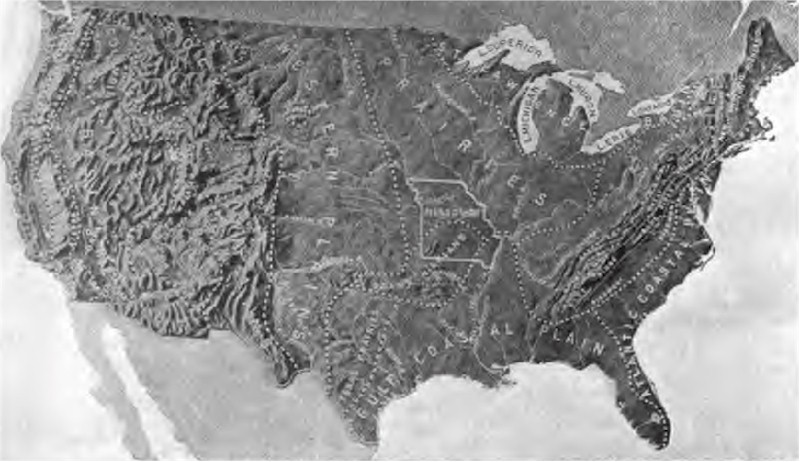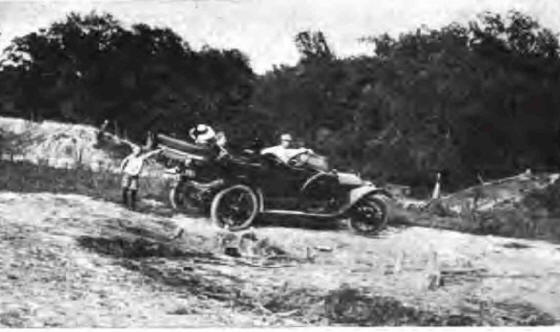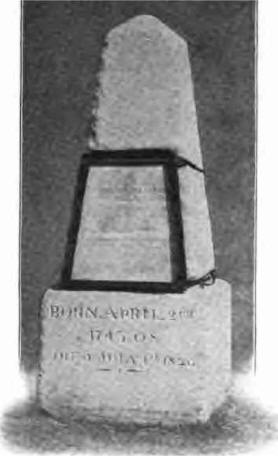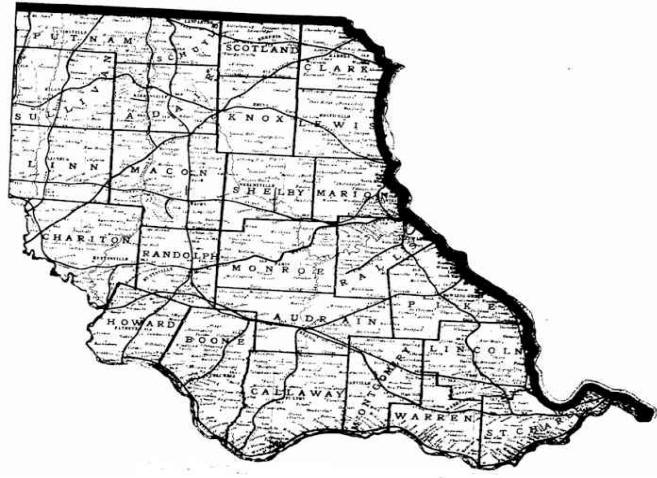The Land and the People

Northeast
Missouri comprises that part of the state of Missouri lying
north of the Missouri River and east of the western boundary of
Chariton County. In the territory thus embraced are the counties
of Adair, Boone, St. Charles, Montgomery, Callaway, Marion,
Audrain, Warren, Lincoln, Pike, Lewis, Clark, Knox, Sullivan,
Macon, Chariton, Randolph, Howard, Monroe, Scotland, Ralls,
Putnam, Schuyler, Linn and Shelby. It is not the oldest section
of Missouri, as far as settlements by the white man make for
age. That distinction belongs to southeast Missouri where is
Ste. Genevieve, oldest of Missouri towns.
First English Settlements in Missouri
In Northeast Missouri, however, were the
first permanent settlements of the English speaking race in
Missouri and the beginnings of its history antedate those of any
other section of the state, excepting southeast Missouri. In
area Northeast Missouri embraces 14,081 square miles. In all
Missouri are 68,736 square miles. The population of all Missouri
counties in the figures of the United States census of 1910 was
3,293,335. Of these 481,008 are in the twenty-five counties of
Northeast Missouri.
In the Boon's Lick country, in St.
Charles County and in the Salt River country were the first
settlements in Northeast Missouri. As all the west, the country
now Northeast Missouri had been peopled with Indians, Sacs,
Foxes, Kickapoos, Pottawatomies, Missouris, tribes that roamed
the plains and slunk through the forest shades even after the
coming of the white man. The pioneers often found the red men
troublesome and, on occasion, murderous neighbors. The Indians
in Missouri were less savage, perhaps, than those of the far
west, but their presence was a source of constant irritation.
When Cols. Benjamin and Sarshall Cooper in 1808 led a band of
Kentuckians to make their homes in Howard County they were
called back by Governor Benjamin Howard nearer the older
settlements because he could give them no protection against
possible Indian outbreaks. In 1810 they returned and Col.
Sarshall Cooper, seated by his own fireside, met death at an
Indian's hand. There were no Indian wars of consequence in
Northeast Missouri. The uprising, in 1832, of Black Hawk and his
band of Indians to the northward stirred up the residents of the
outlying settlements, but the uprising, by the victory of the
whites at the battle of Bad Axe, was soon at an end. The Indian
disturbances were largely local and soon, with the growth of the
white population, ceased altogether. The Indian struggled for a
few years against white occupation, struggled in barbarous
fashion and unsuccessfully, and, then, moved on to the west and
southwest.

Relief Map of the United States, showing the location of
Missouri
French and Spanish Settlers
The earliest successors of the Indian in
Northeast Missouri came from France or Spain. Three gates opened
wide to the Missouri territory in the early days. The Spanish
came by the lower water gate of the Mississippi River, the Great
Water of the Indians, in search of gold; the French first by the
upper water gate of the Mississippi led by Marquette's noble
missionary zeal and later by the lower water gate as well;
through the mountain gate from the eastward came the Virginians,
their children of Kentucky and, in later day, the Scotch-Irish
of farther north. At yet later time came men and women from
north and east and from beyond the sea, all seeking homes where
there was blue sky and elbow room and freedom. No one, save the
earliest Spaniards or an occasional trapper of the fur trade
day, came to Northeast Missouri to make a fortune in mine or
forest and return; he came to make a home and abide in the home.
Homemaking, English speaking folk settled Northeast Missouri,
not gold seeking adventurers. The Spanish are remembered by an
occasional name of town or river and the French in the same wise
or by some ancient family tree.
The Real
Founders
The colonists from east of the
Appalachians seeking homes were the real founders of the early
state. They were of genuine pioneer stock. Some peoples will not
bear transplanting; even in the wilderness others are the
architects of states. Of the latter were the earliest settlers
in Northeast Missouri, hardy, dominant and daring. Missouri,
easily first of all the states in potential resource, is the
product of their handiwork, while every state from the
Mississippi River to the Golden Gate shows their skill in
commonwealth construction. The name of Pike County, Missouri,
has gone abroad in all the land. In struggles with savage beast
and untamed man the pioneer Missourian showed persistent heroism
and hardihood. They were his children who, in the strife between
the states, enlisted to the number of beyond 100,000 in the
Union army and more than 50,000 in the Confederate service,
keeping the state's quota full without draft or enforced
enlistment, not merely in one but in both armies, a record
unexampled among the states, north or south. They were church
going and school encouraging. Within its boundaries are a
majority of the colleges of the state. They had respect for law.
No vigilance committee was needed to preserve order even in the
most primitive community in Northeast Missouri. In the earliest
Missouri constitution Missourians recognized the providence of
God, provided for the establishment of free schools, and planned
for a state seminary of learning, now the State University in
Northeast Missouri. One interior county in Northeast Missouri,
Boone, with population of a scant few hundred, in 1839, gave, by
voluntary subscription, $117,900 for the founding of a college,
a farmer who could neither read nor write heading the
subscription list with $3,000, a gift, considering time and
circumstance, more princely than that of any modem millionaire.
The early residents of Northeast
Missouri were not always from Virginia, the Carolinas, Kentucky
or Tennessee. From the Middle and New England states also they
came. It was a Pennsylvanian, Alexander McNair, who, settling
with his brother in friendly boxing match who should inherit the
old homestead and losing the match, became the first Governor of
Missouri. It was a South Carolinian, Daniel Dunklin, who was the
father of the public school system of the state. From
Connecticut came Rufus Easton, the new state's greatest lawyer.
Tennessee gave Missouri one of her first United States senators,
David Barton, and North Carolina the other, Thomas Hart Benton.
Thomas F, Riddick, who gave to Missouri her public school lands,
going horseback at his own expense from St. Louis to Washington
to plead successfully therefor, John Scott, the first
congressman, Frederick Bates, the second governor, State Senator
Abraham J. Williams, the one-legged cobbler from Columbia who
succeeded Bates as governor, John Miller, who succeeded Williams
and served seven years, the longest term of any Missourian to
hold the office, these were of Virginia nativity. The dominant
life, however, in early Northeast Missouri, in all Missouri, was
Virginian and Kentuckian, tempered by the frontier west.

Daniel Boone
First
Settlers in Northeast
Missouri
Louis Blanchette, surnamed Chasseur, the
Hunter, a gay French sportsman, was probably the first settler
in Northeast Missouri. He wandered from the hamlet of St Louis
in 1769 and built a cabin from which grew "the village of the
hills," afterward St. Charles. The eyes of the white man had
seen the glories of the land. In earlier years. More than a
century before Marquette and Joliet, Jesuit missionaries and
explorers, came down the Mississippi river and doubtless landed
on its attractive western shore. In 1680, a Franciscan friar,
Louis Hennepin, ascended the Mississippi river from the mouth of
the Illinois, staying his frail canoe for occasional converse
with the Indians on the river banks. Trapper and hunter had,
here and there, penetrated the wilderness or rowed upon the
streams, but there was no permanent habitation. Following the
lead of the adventuresome Blanchette, however, settlers began to
enter the territory.
Boone and
English Speaking
Settlers
Not until the closing years of the
eighteenth century, however, did English speaking settlers,
chief among them Daniel Boone, America's most famous
frontiersman, make their homes here. Others came with the birth
of the new century and upon the close of the War of 1812
immigration fairly poured into the new country.
After St. Charles there came the
settlement of the Boon's Lick country and then the lands along
the Missouri river between Boon's Lick and St. Charles. Two sons
of Daniel Boone, Nathan and Daniel M., made salt at the "lick"
in Howard County and shipped it in hollow logs down the Missouri
River to St. Louis. Soon a settlement grew up nearby at Franklin
on the river and the Boon's Lick country, name for all the
region round about, came into existence, with Franklin, soon to
be washed away by the muddy river, as its chief city. To
Franklin came Nathaniel Patten and Benjamin Holliday,
enterprising Missourians, and began the publication, April 23,
1819, of the Missouri Intelligencer and Boon's Lick Advertiser,
the first newspaper west of St. Louis. In the same year the
Independence, Capt. John Nelson commanding, ascended the
Missouri River and made landing at Franklin. "What think you,
Mr. Reader," said the Albany (N. Y.) Ploughman "of a newspaper
at Boon's Lick in the wilds of Missouri, in 1819, where in 1809
there was not, we believe, a civilized being excepting the
eccentric character who gave his name to the spot." Franklin
became the metropolis of the Boon's Lick country. Only a single
brick building, once the Franklin Academy, now remains of all
its early greatness. In Callaway County the village of Cote Sans
Dessein, the hill without design, had been established and in a
few years was the center of a small settlement. In 1812, under
the protection of Capt. William Head's fort in Howard County,
there was a settlement on Thrall's Prairie in Boone County.
Boon's Lick
Road and Immigration
The Boon's Lick road, from St. Charles
westward, surveyed by the Boones in 1815, brought many settlers.
The Intelligencer, April 23, 1819, in one of its brief
references to local affairs, said: "The immigration to this
territory, and particularly to this county, during the present
season almost exceeds belief. Those who have arrived in this
quarter are principally from Kentucky, Tennessee, etc. Immense
numbers of wagons, carriages, carts, etc., with families, have
for some time past been daily arriving. During the month of
October it is stated that no less than 271 wagons and four
wheeled carriages and fifty-five two wheeled carriages and carts
passed near St. Charles, bound probably for Boon's Lick. It is
calculated that the number of persons accompanying these wagons,
etc., could not be less than three thousand. It is stated in the
St. Louis Inquirer of the 10th instant that about twenty wagons,
etc., per week had passed through St. Charles for the last nine
or ten weeks, with wealthy and respectable immigrants from
various states. Their united numbers are supposed to amount to
twelve thousand. The county of Howard, already respectable in
numbers, will soon possess a vast population, and no section of
our country presents a fairer prospect to the immigrant."
Immigration turned toward the north from
St. Louis, the gateway, as toward the west. Maturin Bouvet, a
Frenchman, had found salt springs in Ralls County in 1792 and
shortly afterward, obtaining a grant of land, had built a cabin
and warehouse in Marion County. At the close of the War of 1812,
English speaking settlers, "finding the Boon's Lick country
crowded," moved on to the Salt River country in what is now
Marion, Ralls, Shelby and other counties of that section and
English civilization began.
German Immigrants
Shortly after the English occupancy a
large number of German immigrants came, chiefly as a result of a
book of travels written by a scholarly German, Gottfried Duden,
who had visited St. Charles, Warren and Montgomery counties in
1824. The large German population of St. Charles and its
neighbor counties dates it beginnings to the year 1833 and to
the result of Gottfried Duden 's illuminating volume.
Thus came the early settlers to
Missouri, the Spanish and French, then the English, the German
and people of every nation and speech. It is a composite
citizenship in every sense today.
Pioneers of All Nationalities
The life of the pioneer was one of
hardship and loneliness but of romance. Only men of courage make
successful pioneers. Such were the men who laid the foundations
of Northeast Missouri. The pioneer was in peril of Indian
attack. Beasts seized upon his cattle. He had few books and
scarcely a newspaper. Schools were rare and the school term
brief indeed. Manners were rough. But the pioneer was honest,
brave, hospitable. He gave welcome to every decent stranger. He
was industrious, sober, law abiding. "An amiable and virtuous
man," he is said to have been by the Rev. Timothy Flint, a New
England visitor of 1816. The Spanish and French had sought for
rich mines, for fur trading and for adventure. The English
immigrants looked for agriculture and for homesteads. There was
never dispute or quarrel between the races. The few Spanish and
the more numerous French mixed readily with the English, who
soon far outnumbered the pioneers of different blood.

Boon's Lick in a Case Car, First Automobile, 1912, at
Terminus
of Northeast Missouri's Most Famous Road
The English speaking pioneer differed
from the French pioneer in life as well as in language. Id
nothing was this difference more manifest than in the building
of homes. The Frenchman settled always in villages and his farm,
if land held in common can be called a farm, came to the very
edge of the village. His residence was in the village and he
seldom tilled a farm so far away that he could not at night join
in the amusements of the village. The Englishman, on the
contrary, cleared a farm in the wilderness. He located as far
from a village as the presence of the Indians would permit. He
"never wished to live near enough to hear the bark of his
neighbor's dog." With the French the village came first and then
the farm. With the English the farm came first and afterward the
village.

Original Thomas Jefferson Monument,
University Campus, Columbia
The house of the Englishman was
constructed differently from that of his French neighbor. Both
were log cabins, sometimes of one room, sometimes of two, with a
wide open way between. The French man put his logs on end and
fastened horizontal seats to the walls. The Englishman, however,
laid the logs for his house horizontally, notched them together
at the ends and filled the spaces between with "chinking of mud
and plaster. Hospitality was the rule. The door of the pioneer
home was made of boards, swung on wooden hinges. It was fastened
within by a latch. From the latch a string was hung through an
opening in the door. "The latchstring is always on the outside"
indicated the open hearted welcome. The cabins had windows
without glass. A shutter or greased paper in a sash was used
instead. A "Virginia rail fence" made an enclosure around the
cabin. The chimney was partly of stone and a huge fireplace gave
warmth.
The food and clothing of the pioneer
were products of the land. Bears, deer, turkey and small game
were plentiful. Farm and garden furnished vegetables and from
the com came his bread. Skins of wild animals were made into
rough but substantial garments and the loom in the cabin
furnished homespun clothing. He had little money and little use
for money. His wants were few and he could supply them with
moderate ease. When he would buy anything at the village he
could give peltries in exchange. Barter was common. "Pins,
needles and sheets of coarse writing paper were used as money."
Spanish silver dollars were the coin mostly seen. These were cut
into small pieces known as "bits" for change. The expressions,
"two bits" and "six bits," have not yet disappeared. Thus was
the life of the pioneer.
County of Pike and Missouri "Pikers"
Many Americans, in the early years of
the nineteenth century, believed that the republic of the United
States would not extend beyond the Allegheny Mountains. They
thought the western country a wilderness or desert unfit for
human habitation. Others believed that the country would be
divided into several nations, as they thought it impossible for
so large a territory as that from the Atlantic Ocean to
Louisiana to be successful under one government. It was claimed
by many that the amount of money, $15,000,000, paid by the
United States for Louisiana, was too great. Surely, they said,
the wild land west of the Mississippi was not worth this sum. To
make answer to the criticisms and doubts the Lewis and Clark
expedition was sent out by President Thomas Jefferson in 1804.
Meriwether Lewis and William Clark, officers in the United
States army, were at the head of the expedition which explored
the Missouri River 1,200 miles and crossed to the Pacific Ocean.
This expedition and the later ones under the leadership of
Lieutenant (afterwards General) Zebulon M. Pike were important
and far reaching in their effects upon Northeast Missouri.
Pike's expeditions in 1805, 1806 and 1807, first to the sources
of the Mississippi River and second to the sources of the Platte
and Kansas rivers, turned attention to the Middle West of which
Northeast Missouri was the frontier. Pike's Peak, in Colorado,
and Pike County, in Missouri, are named for the explorer. For
years many persons outside Missouri knew only one county in the
state, the county of Pike in Northeast Missouri, and called all
Missourians '"Pikers."
Initial County
Organization
Five counties were in Missouri territory
in 1812, only one, St. Charles, in all Northeast Missouri. The
western boundary of St. Charles County was the Pacific Ocean and
the northern border the Canada line. When the state came into
the union in 1821 there were fifteen counties, of which ten,
Boone, Callaway, Chariton, Clark, Howard, Lincoln, Montgomery,
Pike, Ralls and St. Charles, were in Northeast Missouri. This
shows the growth of the region. Macon County was organized in
1826; Randolph in 1829; Monroe in 1831; Lewis and Warren in
1833; Shelby in 1835 ; Audrain in 1836; Linn and Macon in 1837;
Adair and Scotland in 1841; Sullivan in 1844; Schuyler, Putnam
and Knox in 1845. These organization dates show the process of
the population.
Boundary Dispute with
Iowa
In 1840 the boundary line between
Northeast Missouri and the state of Iowa was finally settled.
There had been difference of opinion between the officers in the
two states as to the ownership of a strip of land about twenty
miles wide. Instead of pursuing a sensible policy and seeking to
settle the difference by law, each state undertook to enforce
its authority on the disputed strip. Finally troops were called
out by both states. It looked as if there would be war. The
tract of land, mostly covered by forest, was noted for wild bees
and the dispute was called "The Honey War." Seeing the folly of
fighting, it was agreed by both aides to stop war preparations
until the national government could settle the boundary line.
This was done and now in Northeast Missouri the counties of
Clark, Scotland, Schuyler and Putnam have their northern
boundaries, the Missouri Iowa state line, definitely marked by
iron posts, ten miles apart.
St. Charles, Old Missouri
Capital
The capital of Missouri was, for a time,
in Northeast Missouri, at St. Charles, where the building in
which the first general assembly met yet stands. Most of the
members of the first Missouri legislature, in 1820, as well as
the governor and other high dignitaries, rode to St, Charles on
horseback. The members boarded at private houses. Pork sold at
1% cents a pound; venison hams, 25 cents each; eggs, 5 cents a
dozen; honey, 5 cents a gallon; and coffee, $1 a pound. Sugar
was not in the market and those who drank coffee sweetened it
with honey. The legislators dressed in homespun clothes,
buckskin leggins and hunting shirts. Some wore rough shoes of
their own manufacture, while others encased their feet in
buckskin moccasins. Some had slouched hats, but the greater
number wore caps made of the skins of wildcats and raccoons.
Governor McNair was the only man who had a fine cloth coat cut
in the old "pigeon-tail" style. He also wore a beaver hat and
endeavored to carry himself with the dignity becoming a man
holding the highest executive office in the state.
General
Development
The growth and development of Northeast
Missouri, the story of its progress, is told in the separate
county histories. Written by high authorities, they make a real
contribution to the history of the important territory. The life
of the pioneer, the part played by women, the building of
roadways to bind the population together, the waterways, the
organization of churches, the literature, the dark days of the
civil war, the history of the state as a whole, these are
presented adequately and admirably in separate chapters and need
not be considered here.

Map of the twenty-five counties of Northeast Missouri
Northeast Missouri is a section of many
interests. Largely rural, it contains no city of more than
20,000 population. Its chief interest is agriculture, but
manufacturing and mining are of much importance. It is a center
of fine stock growing. Half the land is underlaid with coal.
Diverse industries, an extended crop season and fertility of
soil make, because of the skill, intelligence and energy of the
people, a prosperous community. The Mississippi and Missouri
river bottom lands are like the Nile valley for richness. The
uplands are unexcelled for fruit. The prairies afford abundant
harvests. Nor is there neglect of those things which make for
the higher life of the citizenship.
Eminent
Men
The list of eminent men who have been
residents of Northeast Missouri is a long one. In the county
histories that follow, their names are recorded. Here may be
mentioned, among the dead, James S. Rollins, the eloquent father
of the University of Missouri, Bishop Enoch R. Marvin, James O.
Broadhead, James S. Green, Edward Bates, John Miller, George C.
Sibley, Sterling Price, Claiborne F. Jackson, Charles H. Hardin,
John A. Hockaday, George C. Bingham, Eugene Field, Mark Twain,
Abiel Leonard, James L. Stephens, John H. Lathrop, Daniel Boone,
Kit Carson, soldiers of war and soldiers of peace, educators,
statesmen.
The spirit of its people is the spirit
of progress, tempered by sane conservatism. It rejects not the
old because of its age nor refuses the new because it is not
old. It is the spirit of a community conscious of its own secure
position, somewhat too careless at times of the world's opinion,
hospitable, generous, brave. The dream of the greatest statesman
is a nation of citizens dwelling in happy homes. In Northeast
Missouri the dream finds realization.
A Home History of a Home
Land
This is a home history, not a story of
trumpet and drum, and is told by men who live among and know the
people. The individual county histories and special chapters,
gathered by, this editor to give comprehensive and composite
view of Northeast Missouri, have been written with fine
discrimination and loving, sympathetic hand. They record the
Missourian's good deeds and the rich romances of his life for
the edifying of the generations that come after him.
This is a home history of a home land.
Long the western outpost of American civilization, its chief
contribution to history is the homes it founded in the
wilderness and sustained amid privation, stress and danger unto
the abundant home life of today. The energy the old home of
Northeast Missouri stored, the iron it put into the blood, the
clear eyes and unclouded brain and the faith and love it has
bequeathed enable the men and women of today to walk in
straighter path and more safely. This home, in country or on
city street, is the old Missouri's heritage to humanity. First
of all and always the Missourian was a home builder. And with
the perishing of the homes he builded and others like unto them,
the republic, no matter its cities or its commerce, its courts
or its governors, will be at an end. Upon the historic past we
build the historic present. The New Missouri rests upon the Old
Missouri.
Let those in Northeast Missouri who know
tell of the Old and of the New, a home history of a home land.
Northeast Missouri|
AHGP
Missouri |
Books
on AHGP

Source: History of Northeast Missouri,
edited by Walter Williams, Volume I, Lewis Publishing Company,
1913
|


